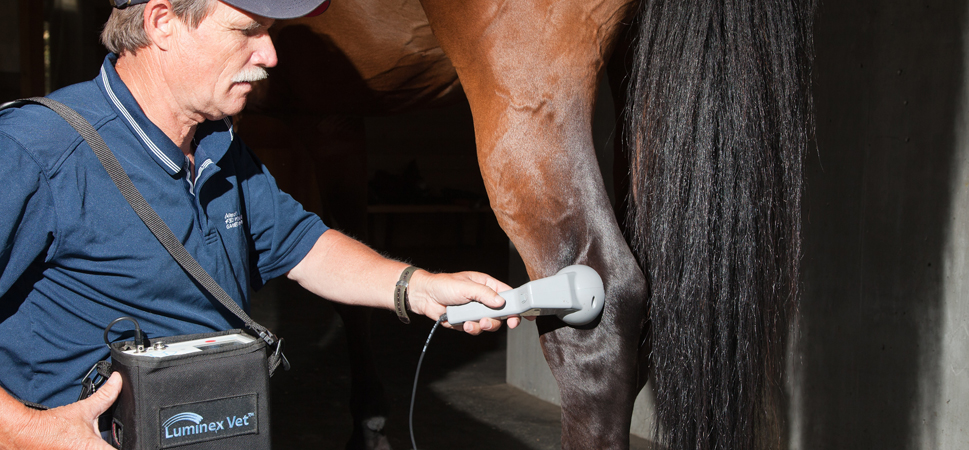Laser Therapy in Horse Treatment: A Modern Approach to Improving Steed Health And Wellness
Laser therapy has actually arised as a critical method in equine therapy, utilizing concentrated light energy to promote mobile repair and accelerate recuperation from a selection of ailments. By promoting mitochondrial activity and improving ATP manufacturing, laser treatment not only enhances circulation however additionally provides substantial pain relief.
Comprehending Laser Treatment
Laser treatment, a non-invasive therapy method, has actually obtained substantial grip in equine medication due to its efficacy in promoting healing and pain alleviation. This advanced restorative approach utilizes focused light energy to penetrate cells, cultivating mobile fixing and regrowth. The underlying device entails the excitement of mobile mitochondria, causing boosted production of adenosine triphosphate (ATP), the energy currency of cells. Boosted ATP degrees accelerate cells repair work processes and reduce swelling, making laser treatment especially efficient for treating bone and joint injuries, injuries, and various other inflammatory conditions in horses.
There are numerous kinds of lasers used in equine treatment, each with particular wavelengths and power outputs customized to different healing requirements. Low-level laser treatment (LLLT), likewise called cool laser therapy, uses reduced power levels to boost cell function without creating thermal damage. High-intensity laser treatment (HILT), on the other hand, uses higher power levels to attain deeper cells penetration and even more significant healing effects.
Veterinarians make use of different laser tools and methods relying on the condition being dealt with and the preferred deepness of tissue infiltration. Proper training and know-how are important for guaranteeing the secure and effective application of laser treatment, thereby optimizing its therapeutic capacity while decreasing risks.
Advantages for Equine Health And Wellness
With a strong understanding of exactly how laser treatment functions, it is vital to discover its many advantages for equine health and wellness. One of the key advantages is its capability to increase cells fixing and cell development. By boosting mobile feature, laser treatment advertises faster injury recovery and help in the regrowth of damaged tissues. This can be particularly helpful in decreasing recuperation times for steeds experiencing injuries.
Moreover, laser treatment has actually been shown to boost circulation, thereby improving blood circulation to impacted areas. Enhanced flow guarantees that vital nutrients and oxygen are provided much more efficiently, facilitating the healing process. Furthermore, laser therapy's anti-inflammatory results assist in reducing swelling and pain, which is crucial for the total health of the equine.
Discomfort monitoring is another significant advantage. By releasing endorphins and obstructing pain signals, laser treatment offers effective, non-invasive alleviation from both severe and persistent pain. This can add to enhanced mobility and lifestyle for the animal.
Last but not least, laser therapy is a non-invasive therapy option, lessening the risk of difficulties connected with even more invasive procedures. Its versatility and effectiveness make it an indispensable device in modern horse vet medicine.
Typical Problems Treated

Another prevalent condition treated with laser therapy is arthritis. Equines dealing with both severe and persistent joint inflammation advantage from the anti-inflammatory results of laser therapy, which aids to relieve discomfort and boost joint feature. In addition, laser treatment is used in the management of injuries. Whether managing medical cuts or distressing injuries, the pop over to these guys technique advertises quicker tissue repair work and decreases the risk of infection.
Equine respiratory conditions, such as recurrent respiratory tract blockage (RAO), likewise respond positively to laser treatment. The anti-inflammatory buildings of the therapy aid in reducing airway swelling, therefore improving respiratory system function. Furthermore, laser therapy is beneficial in dealing with hoof troubles, consisting of laminitis and abscesses. By enhancing blood circulation and decreasing pain, it sustains quicker recovery.
Treatment and Safety
Carrying out laser therapy in equine therapy involves a careful treatment to make sure both efficiency and security. Equine Therapy. The procedure begins with a detailed veterinary analysis to determine the viability of laser treatment for the horse's certain condition. When regarded suitable, the therapy location is prepared by cleaning and, if needed, clipping the hair to enhance laser penetration
The professional must select the right sort of laser, generally a low-level laser (LLLT) or a high-power laser (HPL), relying on the condition being dealt with. The laser tool is then calibrated to the suitable wavelength, power, and period setups. Throughout the application, the practitioner relocates the laser over the targeted location in an organized manner, making certain consistent and even exposure.
Security procedures are purely stuck to, consisting of using protective eyewear for both the specialist and the equine. Furthermore, it is critical to monitor the horse for any indications of discomfort or damaging responses throughout the treatment. Post-treatment, the steed is often given a period of rest to enable the restorative impacts to show up.

Future of Horse Laser Treatment
As innovations in veterinary medication continue to unravel, the future of equine laser therapy holds considerable assurance. Emerging technologies and much deeper clinical insights are set to improve and increase the applications of laser therapy for horses. Among one of the most expected developments is the integration of innovative imaging strategies that permit for a lot more accurate targeting of affected cells, consequently enhancing healing outcomes. Additionally, the growth of portable and easy to use laser gadgets is likely to make this therapy extra available to a wider variety of practitioners and steed owners.
Additionally, recurring research study into the molecular and mobile mechanisms of laser therapy will likely generate optimized methods customized to certain problems, enhancing performance and decreasing therapy times. Personalized treatment strategies based upon genetic and biochemical pens can come true, ensuring that each equine obtains the most suitable and efficient treatment.
Additionally, regulative innovations and standardization of protocols will boost the reliability and dependability of laser treatment in equine practice. Equine Therapy. As these developments continue to arise, equine laser treatment is positioned to become an important part of vet treatment, offering boosted healing and improved quality of life for equines internationally
Verdict
